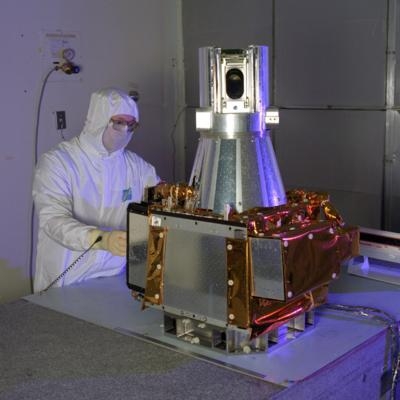Launch Aboard SpaceX Falcon 9 Booster Scheduled For Saturday
Two Ball Aerospace-built payloads will soon blast off toward the International Space Station aboard a SpaceX Dragon spacecraft. Scheduled for a February 18 launch from NASA's Kennedy Space Center, the two Ball instruments will play critical roles in the International Space Station's scientific and environmental observations and technical operations.

"Ball has a deep legacy in creating instruments and spacecraft for NASA, from helping to measure ozone levels to exploring the farthest reaches of our solar system and beyond," said Jim Oschmann, Ball Aerospace's vice president and general manager, civil space business unit. "We are proud to support the ongoing operations of the International Space Station and to further scientific understanding of how the ozone layer affects life on Earth."
Ball built the Stratospheric Aerosol and Gas Experiment III on the International Space Station, also known as SAGE III on ISS, and designed and built the Vision Navigation Sensor (VNS) for Raven, a technology demonstration that will test autonomous rendezvous capability for future uses with unmanned vehicles in space and on Earth.
SAGE III on ISS, which was designed at NASA's Langley Research Center in Hampton, Virginia, is a key part of NASA's mission to provide crucial, long-term measurements that will help determine the health of the ozone layer. The heart of the SAGE III on ISS instrument is the Ball-built spectrometer, which allows scientists to measure the quantity of atmospheric gases such as ozone, nitrogen dioxide, water vapor and aerosols in the Earth's atmosphere. Ball built three SAGE III instruments dating back to the selection as prime contractor in November 1989 by NASA Langley. Once docked with the ISS, the SAGE III payload will collect measurements through each sunrise and sunset from its orbit approximately 450 kilometers above the Earth's surface.
Ball's deep heritage with ozone mapping and monitoring extends more than 40 years. Beginning in the 1970s, Ball built a number of stratospheric aerosol instruments for NASA demonstrating the ability to measure ozone from space, and went on to build nine SBUV/2 instruments that helped discover the ozone hole above Antarctica in 1987 and which have operated since 1984. More recently, Ball designed and built the Ozone Mapping and Profiler Suite (OMPS) currently flying on NOAA's Suomi-NPP operational environmental satellite, and will deliver four additional OMPS units for the JPSS series of satellites beginning Fall 2017 and continuing through the early 2030s.
Raven is a technology demonstration mission led by NASA's Goddard Space Flight Center to advance the state-of-the-art in rendezvous, proximity operations, and docking. Raven includes visible cameras, an infrared camera and a flash LIDAR, called the Vision Navigation Sensor (VNS). In building and designing the VNS, Ball has provided Raven with its "eyes," which will watch vehicles approach and depart the ISS.
(Image provided with Ball Aerospace news release)
 Classic Aero-TV: VerdeGo Debuts VH-3 Hybrid-Electric Powerplant
Classic Aero-TV: VerdeGo Debuts VH-3 Hybrid-Electric Powerplant NTSB Prelim: Grumman American Avn. Corp. AA-5B
NTSB Prelim: Grumman American Avn. Corp. AA-5B ANN's Daily Aero-Linx (12.02.25)
ANN's Daily Aero-Linx (12.02.25) Aero-News: Quote of the Day (12.02.25)
Aero-News: Quote of the Day (12.02.25) Aero-News: Quote of the Day (12.03.25)
Aero-News: Quote of the Day (12.03.25)



